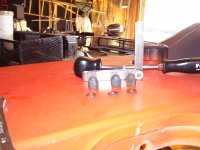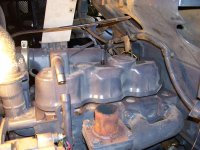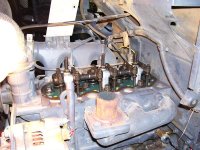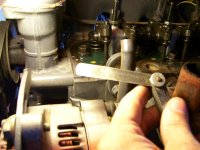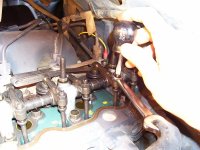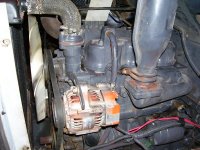RobJ
Elite Member
I pulled the valve cover this weekend to set the valves, took some pictures and thought I'd share what I found. Of the 6 valves I have, 5 were way loose, about double of spec. 1 was a little tight. My tractor has about 1200 hours and I bet it had never been done. No I couldn't tell if it ran better but it was closer to spec. The manual says to set it every 800 hours.
Setting valves not a biggie, I used a set of go,no-go feeler gauges. I removed the muffler for more work room. Valve cover comes off with 3 cap nuts, look for the copper washer. The valve cover gasket is an o-ring type set up, no sealer needed and the gasket was reusable. Since I used to do this I've set many of valves, and on the Kubota I only found 1 thing that can bit someone that wasn't watching closely. As I tightened with the gauges, the adjustment felt mushy. Since these are low revving engines, the valve springs are VERY weak. Not sure what the spec is but I could reach in with 2 fingers and press them down pretty easy. So slipping the feeler gauge to the NOGO part was actually openning the valves a bit giving me a false reading. I've never had this happen before. So setting with the gauges I had to lightly screw it down, then lock the screw. In hindsight, the go-nogo gauges were not the best thing. Because of the tight conditions, a set of dogleg feelers would have been the best. The spec for my tractor is .007-.009". I set them at .008". Turning the engine over is not a biggie, I can usually turn the fan and the belt is tight enough to roll the engine, just get the valves past overlay a quarter turn and set. The manual has a procedure for setting the, in 2 passes.. It's set the #1 on TDC, set #1 intake/exhaust, #2 Exhaust, #3 intake. Rotate the engine 360 degrees and set the others on #2 and #3. Ok now the question is which one is #1. Uhhh I haven't figured that out just yet. The manual says 1-2-3 starting "from the gear case side". That's a quote. So is that the tranny gear case side? Or the front cover gear case side. One day I'll check this out. In other engines I've worked on it would say "starting at the flywheel, or the front of the engine. If I had to flip a coin I'd say the one nearest the flywheel is #1. But I usually lose a 50/50 bet.
So some pictures.
Setting valves not a biggie, I used a set of go,no-go feeler gauges. I removed the muffler for more work room. Valve cover comes off with 3 cap nuts, look for the copper washer. The valve cover gasket is an o-ring type set up, no sealer needed and the gasket was reusable. Since I used to do this I've set many of valves, and on the Kubota I only found 1 thing that can bit someone that wasn't watching closely. As I tightened with the gauges, the adjustment felt mushy. Since these are low revving engines, the valve springs are VERY weak. Not sure what the spec is but I could reach in with 2 fingers and press them down pretty easy. So slipping the feeler gauge to the NOGO part was actually openning the valves a bit giving me a false reading. I've never had this happen before. So setting with the gauges I had to lightly screw it down, then lock the screw. In hindsight, the go-nogo gauges were not the best thing. Because of the tight conditions, a set of dogleg feelers would have been the best. The spec for my tractor is .007-.009". I set them at .008". Turning the engine over is not a biggie, I can usually turn the fan and the belt is tight enough to roll the engine, just get the valves past overlay a quarter turn and set. The manual has a procedure for setting the, in 2 passes.. It's set the #1 on TDC, set #1 intake/exhaust, #2 Exhaust, #3 intake. Rotate the engine 360 degrees and set the others on #2 and #3. Ok now the question is which one is #1. Uhhh I haven't figured that out just yet. The manual says 1-2-3 starting "from the gear case side". That's a quote. So is that the tranny gear case side? Or the front cover gear case side. One day I'll check this out. In other engines I've worked on it would say "starting at the flywheel, or the front of the engine. If I had to flip a coin I'd say the one nearest the flywheel is #1. But I usually lose a 50/50 bet.
So some pictures.
